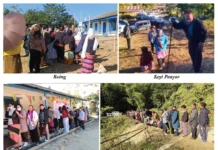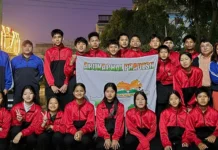[ Dr Saroj Kumar Pattanaaik ]
Erratic rainfall and dry period from October to March hinders horticultural productivity in Arunachal Pradesh. The state receives ample rainfall of about 3,500 mm in a year. In spite of this, the horticultural crops planted on hill terraces and valleys suffer from water stress during winter, ie, October to March. The water and nutrient shortage is one of the major factors for lower productivity of horticultural crops in the state. Torrential rainfall during the rainy season drains the nutrients, causing the horticultural plants to be stressed with water and nutrients.
Efforts are being made by the College of Horticulture and Forestry (CHF) in East Siang HQ Pasighat to standardize the cost-effective rainwater harvesting technology. The technology has been standardized as ‘silpaulin-lined rainwater harvesting technology’ and many such cost-effective ponds have been constructed in the college, and the harvested water is utilized for lifesaving irrigation for the horticultural crops.
The technology has been found to be an efficient one in the agro-climatic condition of the Northeast region of India. In Arunachal Pradesh, the farmers are aware of the benefits of implementing this technology through a series of extension programmes like training and demonstration. The technology has been adopted by citrus growers, vegetable farmers, oil palm growers and fish farmers of Arunachal Pradesh.
Progressive farmers Pumto Perme (of Ayeng village), Kabit Tayeng (of Bodak village) and Daggam Riba (of Pagi-I village) have implemented the technology with their personal inclusion of suitable enterprises. Taker Taloh, of Ruksin, has started constructing silpaulin-lined rainwater harvesting ponds to save his orchard of Khasi mandarin.
In addition to rainwater-harvesting ponds, enterprises like polyhouse cultivation of king chilli, leafy vegetables, capsicum, cucumber and red cabbage; open cultivation of Khasi mandarin orange, arecanut, colocasia, field pea, potato, cabbage, etc, and rearing of fish like silver carp, catla, grass carp and local fishes are included by the farmers.
Construction of silpaulin-lined ponds Utilization of unused, naturally depressed areas can be converted into low-cost silpaulin-lined water harvesting ponds. The dimensions of the ponds are based on the enterprises to be associated with it. The construction of the ponds is completed preferably before March. The excavated gravelly/stony soil is kept as an embankment surrounding the pond. A trench of at least 1 x 1 is made surrounding the upper surface of the pond. The surface of the pond is then laid by 10-15 cms soil cushioning with subsequent laying of 250 gsm finish size silpaulin films.
Freeboard of 30 cms is kept by providing a pipe spillway to dispose of excess rainwater falling into the pond. The life of the film is about seven years with direct exposure to sun. Life is more than 12 years if it is dipped inside water.
Utilization of harvested water
The pond gets filled with rainwater by the month of July. The harvested water is pumped to irrigate various horticultural crops through the micro-irrigation system. Solar pumps are a suitable option for this as the sky remains clear during the winter months in Arunachal Pradesh. In the cultivated lands of hill slopes, solar pumps are a viable option. Fish cultivation is practiced in the harvested water of the pond.
Outcome of the technology
At the CHF and the College of Agriculture in Pasighat, many rainwater harvesting ponds have been constructed. The water is utilized judiciously for irrigating various horticultural crops, and the outcomes are as follows.
1) In the case of open cultivated cabbage (BC-76 hybrid), yield of 3.19 tonnes/ha is produced.
2) In the case of cowpea (kashi kanchan), a yield of 3.3 tonnes/ha is produced.
3) In the case of okra (arka anamika), a yield of 4.2 tonnes/ha is produced.
4) In the case of greenhouse-cultivated king chilli, 200 fruits @ 8 gms per plant is produced.
5) In the case of polyhouse-cultivated cucumber, 25 kg fruits per plant are produced.
6) In the case of polyhouse-cultivated yellow capsicum (F1 sauna), a yield of 25 tonnes per acre is produced.
7) The mean yield of fishes from the silpaulin-lined pond is 15.1 q/ha by practicing composite fish farming system.
In the case of farmers like Karme Riba, of Regi village in Leparada district, a progressive farmer could get Rs 40,000 by cultivating king chillies in a polyhouse.
Rainwater harvesting-based integrated farming system is an economical and viable practice which can be adopted by the farmers of the Northeast region. The farmers have been practicing integrated farming system for long, which is why there are no farmers’ suicides in the Northeast. But they can be advised about improvement by scientifically doing the practice. No open vegetable cultivation is possible in the Northeast due to torrential rainfalls and floods. The cost of vegetables is high due to unfavourable climatic condition during the rainy season. Polyhouse cultivation of vegetables is a viable option in the hill slopes during the rainy season. (The contributor is HoD, Natural Resource Management, CHF, Pasighat. He can be reached at spattanaaik@gmail.com).



